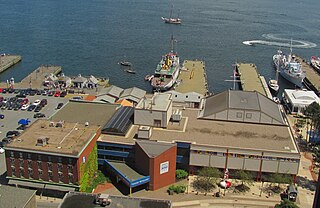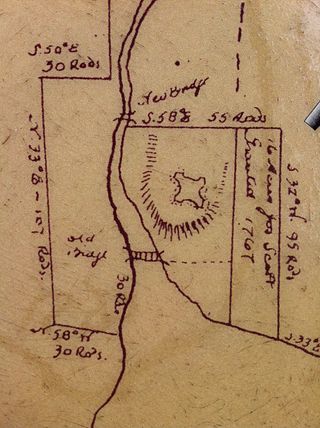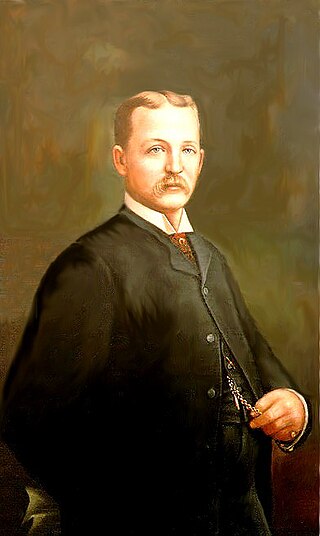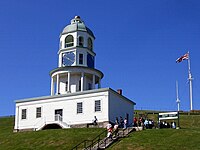
Sir Samuel Cunard, 1st Baronet, was a British-Canadian shipping magnate, born in Halifax, Nova Scotia, who founded the Cunard Line, establishing the first scheduled steamship connection with North America. He was the son of a master carpenter and timber merchant who had fled the American Revolution and settled in Halifax.

The Maritime Museum of the Atlantic is a maritime museum located in downtown Halifax, Nova Scotia, Canada.

Michael John Savage is an Irish-born Canadian politician, who was elected Mayor of the Halifax Regional Municipality on October 20, 2012. He previously served as a Liberal Party of Canada Member of Parliament for the riding of Dartmouth—Cole Harbour from 2004 to 2011.

NSCAD University is a public art university in Halifax, Nova Scotia, Canada. The university is a co-educational institution that offers bachelor's and master's degrees. The university also provides continuing education services through its School of Extended Studies.

Edward Miner Gallaudet, son of Thomas Hopkins Gallaudet and Sophia Fowler Gallaudet, was the first president of Gallaudet University in Washington, D.C. from 1864 to 1910.

SS Royal William was a Canadian side-wheel paddle steamship that is sometimes credited with the first crossing of the Atlantic Ocean almost entirely under steam power, in 1833, using sails only during periods of boiler maintenance. She was the largest passenger ship in the world from 1831 to 1839, where it was then passed by the SS Great Western . Earlier vessels that crossed partially under steam include the British-built Dutch-owned Curaçao in 1827 and the sail-steam hybrid SS Savannah in 1819.

McNabs Island is the largest island in Halifax Harbour located in Halifax Regional Municipality, Nova Scotia, Canada. It played a major role in defending Halifax Harbour and is now a provincial park. The island was settled by Britons in the 1750s and later by Peter McNab, and McNab family members lived on the island until 1934.
Thomas Braidwood (1715–1806) was a Scottish educator, significant in the history of deaf education. He was the founder of Britain's first school for the deaf.

Halifax Public Libraries (HPL) is a Canadian public library system serving residents of Halifax, Nova Scotia. It is the largest public library system in Nova Scotia, with over 2.8 million visits to library branches and 172,520 active registered borrowers or 44% of the municipality's population. With roots that trace back to the establishment of the Citizens' Free Library in 1864, the current library system was created in 1996 during municipal amalgamation, and now consists of 14 branches and a collection of almost 1 million items.

Robie Street is a north-south artery that runs for 7 km in the Halifax Peninsula area of the Halifax Regional Municipality, from Memorial Drive in the North End Halifax, to Gorsebrook Avenue in the South End.

The history of Nova Scotia covers a period from thousands of years ago to the present day. Prior to European colonization, the lands encompassing present-day Nova Scotia were inhabited by the Mi'kmaq people. During the first 150 years of European settlement, the region was claimed by France and a colony formed, primarily made up of Catholic Acadians and Mi'kmaq. This time period involved six wars in which the Mi'kmaq along with the French and some Acadians resisted the British invasion of the region: the French and First Nation Wars, Father Rale's War and Father Le Loutre's War. During Father Le Loutre's War, the capital was moved from Annapolis Royal, Nova Scotia, to the newly established Halifax, Nova Scotia (1749). The warfare ended with the Burying the Hatchet ceremony (1761). After the colonial wars, New England Planters and Foreign Protestants immigrated to Nova Scotia. After the American Revolution, Loyalists immigrated to the colony. During the nineteenth century, Nova Scotia became self-governing in 1848 and joined the Canadian Confederation in 1867.
Soccer Nova Scotia is the governing body for soccer in the Canadian province of Nova Scotia. It is a member association of the Canadian Soccer Association. It has jurisdiction over the Nova Scotia Soccer League.
Daniel McNeill Parker was a physician and political figure in Nova Scotia. He served in the Legislative Council of Nova Scotia from 1867 to 1901.

The Naval Museum of Halifax is a Canadian Forces museum located at CFB Halifax in the former official residence of the Commander-in-Chief of the North America Station (1819–1905). Also known as the "Admiralty House", the residence is a National Historic Site of Canada located in Halifax, Nova Scotia, Canada. The museum collects, preserves and displays the artifacts and history of the Royal Canadian Navy.

The Halifax Club is a private club in Halifax, Nova Scotia that was established in 1862. The club serves as a meeting place for business-minded men and women. It is a place where they can "meet, toast the day's successes, dine or simply relax in a warm atmosphere of history and tradition." The Club has a substantial art collection including a self-portrait of Benjamin West and a painting by Robert Field. The Club was built by George Lang.

Fort Sackville was a British fort in present-day Bedford, Nova Scotia. It was built during Father Le Loutre's War by British adjacent to present-day Scott Manor House, on a hill overlooking the Sackville River to help prevent French, Acadian and Mi'kmaq attacks on Halifax. The fort consisted of a blockhouse, a guard house, a barracks that housed 50 soldiers, and outbuildings, all encompassed by a palisade. Not far from the fort was a rifle range. The fort was named after George Germain, 1st Viscount Sackville.
James Gordon MacGregor, FRS FRSE LLD was a Canadian physicist. He was described as "brilliant, energetic, nervous, impatient", and not suffering fools gladly.

The Halifax School for the Blind opened on Morris Street, Halifax, Nova Scotia as the Halifax Asylum for the Blind in 1871, the first residential school for the blind in Canada. The first superintendent of the school (1873-1923) was Sir Frederick Fraser who was himself visually impaired and had studied at the Perkins School for the Blind in Boston.

James Scott Hutton was the first principal of the Halifax School for the Deaf, and remained with the school for 34 years until his death in 1891. The Halifax School for the Deaf was the first school of the deaf in Atlantic Canada (1856). Along with teaching sign language, Hutton followed the lead of fellow Nova Scotian and advocate for the deaf Alexander Graham Bell by integrating lip-reading into the curriculum. From 1878 to 1882 he served as principal of a similar institution in Belfast.

Samuel Thomas Greene was a Deaf American educator and Ontario's first Deaf teacher in 1870 at the Ontario Institution for the Education of the Deaf and Dumb, which later changed to Sir James Whitney School of the Deaf in Belleville, Ontario, Canada. He was born in 1843 in Portland, Maine and attended America's first Deaf school in Hartford, Connecticut.



















